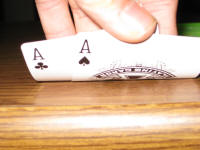Playing Big Pocket Pairs Postflop in No Limit Hold'em
(This article is a follow up to "Playing Big Pocket Pairs Preflop")
 Playing big pairs postflop is one of the toughest spots in No Limit
Hold'em. Many flops leave your big pair vulnerable, so it is important
to be able to read your opponent to determine if you have him/her
dominated, or if it's the other way around. Many players would prefer to get all their money in preflop with a big pair, but that is a weak way to play the hand, and will lose you money in the long run. By taking a sensible preflop approach, and then playing wisely postflop, you will make much more money with big pairs.
Playing big pairs postflop is one of the toughest spots in No Limit
Hold'em. Many flops leave your big pair vulnerable, so it is important
to be able to read your opponent to determine if you have him/her
dominated, or if it's the other way around. Many players would prefer to get all their money in preflop with a big pair, but that is a weak way to play the hand, and will lose you money in the long run. By taking a sensible preflop approach, and then playing wisely postflop, you will make much more money with big pairs.
This article will help you win more money when your big pair is good, and lose less money when your big pair is dominated.
Over Pair to the Flop
A lot of times a hand like KK or AA will end up being an over pair on the flop, meaning that all the other cards are below your pair. If the board comes out as all under cards (think Jh-7c-3s), your big pair is in pretty good shape. There are no draws that could hurt you, and it's unlikely that anyone called your preflop raise with a hand like J-7. You are ahead of almost every likely hand here besides a set.
In the above situation you want to lead out for about 2/3 the size of the pot. This accomplishes two things:
- It shows that you have a strong hand, so someone with a hand like A-K will fold.
- It will entice action from someone with a hand like A-J or K-J. If they raise you, you can re-raise and hopefully take all of their money right there.
If you are in late position you would play this hand the same way. When your opponents check to you on the flop, fire out for about 2/3 the pot. If someone plays back at you, it's a bit of a tough spot, because many people will check-raise with sets, but many people also check-raise with top pair. In this situation it is up to your judgment to determine if you are ahead or if you are dominated.
Flopping a Set on a Dangerous Board
One of the most peculiar hands to play is flopping a set with a big pair on a dangerous drawing board, such as three to a straight or three to a flush. Although you have an incredibly strong hand you are still very susceptible to draws, and may even be behind if your opponent has a made flush or straight.
However, the odds dictate that you probably hold the most powerful hand on the flop. This means that you need to bet the pot hard in order to force out weak draws. Play it just as you would an over pair; make a bet of roughly 2/3 the size of the pot. A bet just under the size of the pot may deter a player with a major draw from continuing in the hand, which is exactly what you are hoping to do.
If you are raised after betting the flop (whether it be check-raised or player raising behind you), odds are he has a large hand as well. Now deciphering which hand he has is the most difficult. Odds are he has one of three hands: a lower set, a high pair with a flush draw or straight draw, or a made straight or flush.
Now considering that you have two of these hands beat, and are still drawing against a flush or straight, it may be far too difficult to get away from this hand. In this case getting all-in may be inevitable, but it is likely that the all-in is in your favor. If you are re-raised in this case, pushing all-in is the best action.
Under Pair on the Board
If there is an under pair on the flop, you need to play your big pair fast and aggressively. An under pair on the flop is a pretty dangerous board, so you want to find out right away if you are still ahead or not. Imagine that the flop comes out J-J-3, and you hold pocket Queens. If there were two other players who called your preflop raise, it is fairly likely that one of those players has a Jack.
You should lead out with a bet of around half the size of the pot, and be very careful if someone simply calls behind you. A player with AJ or KJ will probably slow play the trips, however, if they are holding a mid-pair they may believe you are continuation betting and attempt to call your "bluff." That is why you should bet out - to receive value if another player has a mediocre hand, and to set yourself up to later learn if you are behind.
If a player smooth calls your bet on the flop, and then fires out hard on the turn or river, throw your hand away.
